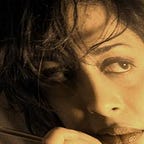The Dark Night: The Bat (1959)
The film version of Mary Rinehart Roberts’ country house mystery launched Vincent Price’s horror career
It’s not often that a turn of the century mystery novel can be crediting for inspiring iconic superhero, but that’s just what happened with Mary Rinehart Roberts’ 1908 novel The Circular Staircase. When it was adapted into a stage play, the masked villain took on the nickname “The Bat.” The play became a 1930 movie, and a young artist named Bob Kane got inspiration for his next superhero — Batman. The Bat was adapted again in 1959 and with just a few changes and the fortuitous casting of Vincent Price, the movie became a classic of retro-horror.
The Story
(Note: The story of The Circular Staircase (novel) and The Bat (play) differ considerably. The following is a summary of novel).
Elderly spinster Rachel Innes decides to rent a country house with her niece and nephew, Gertrude and Halsey. The owner of the house, a bank president, has just died and his bank is almost failing because a large sum of money has been stolen. On the first night, Rachel is sure she hears a trespasser and someone falls down the stairs. On the second night, there is a body is found that no one recognizes. Halsey and Gertrude are hiding secrets, and when the body is identified as Alan Armstrong, the president of the bank, both his wife and former doctor urge Rachel to leave. But she refuses, believing the truth of the mystery is connected to the house.
The Adaptation
Mary Roberts Rinehart wrote The Circular Staircase in 1908, and it was adapted into a silent film in 1915 which has now been lost. Rinehart then began to work on adapting her novel for theatre. The result, The Bat was extremely successful, running for over 800 performances in New York and touring other cities. Since many elements were changed, Rinehart considered the play to be unconnected to her novel and tried to adapt separately adapt The Circular Staircase for film, with no success. Meanwhile, The Bat was adapted into film three times: 1926, 1930 and 1959.
The Circular Staircase is part comedy, part mystery, with a fair sprinkling of romance. It created the “Had-I-But-Known” genre, the narrator already knows what is going to happen, but keeps it from the reader to add suspense. While there are some scary moments, the novel is mostly about secrets and confusion; Rachel is sure something strange is happening and is eager to resolve it. For a turn-of-the-century character, she is bold, independent and practical. Modern readers should be warned, however, that in keeping with the time period, minorities, particularly African Americans, are depicted as derogatory stereotypes. Most of the clues are original, and the novel doesn’t have the quick pace of later mystery novels — but, then again, it was written about 20 years before Agatha Christie’s first book.
The major difference between the original novel and the play/films was the creation of the colorful and melodramatic villain known as The Bat who wears a bat costume and who kills apparently at random. While the villain of the novel is often masked, The Bat is a larger-than-life villain who creates terror among the townspeople, making the movie more of a light horror film than an actual murder mystery. Rachel becomes writer Cornelia Van Gorder, played by Agnes Moorehead, and the niece and nephew are replaced by her maid Lizzie. Cornelia is a hard-headed career woman with no patience for the supernatural stories surrounding The Bat, but as the body count increases, she begins to be afraid for her life.
Vincent Price plays the role of the local town doctor and bat enthusiast. Early in his career, he was known for being the debonair second lead, but here there is the tell-tale hint of menace in his elegance that predicts his future as the king of horror. The Bat makes use of shadows and female hysteria to create an aura of fear around the spooky old house; the practical reasons for the crime and the lurking stranger take a backseat to the idea that there is a monster killing at random. It’s probably no accident that Rinehart’s comedy-mystery was more popular as a ghost story veering on the supernatural, and that The Bat found more fans in the horror genre than with mystery lovers. Though he adaptation has a quaintness for being made in the late 1950’s, but the mood predicts the rise of the B-horror films that would make Vincent Price a legend.
